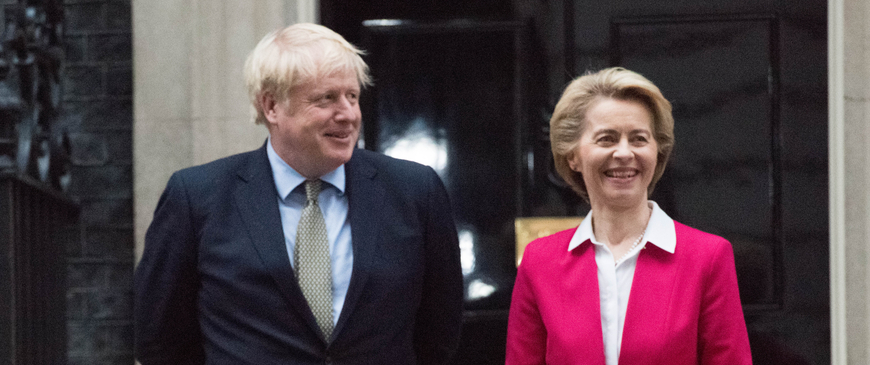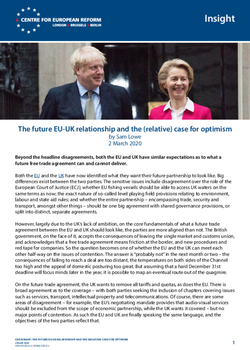
The future EU-UK relationship and the (relative) case for optimism
Beyond the headline disagreements, both the EU and UK have similar expectations as to what a future free trade agreement can and cannot deliver.
Both the EU and the UK have now identified what they want their future partnership to look like. Big differences exist between the two parties. The sensitive issues include disagreement over the role of the European Court of Justice (ECJ); whether EU fishing vessels should be able to access UK waters on the same terms as now; the exact nature of so-called level playing field provisions relating to environment, labour and state aid rules; and whether the entire partnership – encompassing trade, security and transport, amongst other things – should be one big agreement with shared governance provisions, or split into distinct, separate agreements.
However, largely due to the UK’s lack of ambition, on the core fundamentals of what a future trade agreement between the EU and UK should look like, the parties are more aligned than not. The British government, on the face of it, accepts the consequences of leaving the single market and customs union, and acknowledges that a free trade agreement means friction at the border, and new procedures and red tape for companies. So the question becomes one of whether the EU and the UK can meet each other half-way on the issues of contention. The answer is “probably not” in the next month or two – the consequences of failing to reach a deal are too distant, the temperatures on both sides of the Channel too high and the appeal of domestic posturing too great. But assuming that a hard December 31st deadline will focus minds later in the year, it is possible to map an eventual route out of the quagmire.
A deal between the EU and the UK by the end of the year is still possible. But it will require both parties to drift away from their opening position.
On the future trade agreement, the UK wants to remove all tariffs and quotas, as does the EU. There is broad agreement as to the coverage – with both parties seeking the inclusion of chapters covering issues such as services, transport, intellectual property and telecommunications. Of course, there are some areas of disagreement – for example, the EU’s negotiating mandate provides that audio-visual services should be excluded from the scope of economic partnership, while the UK wants it covered – but no major points of contention. As such the EU and UK are finally speaking the same language, and the objectives of the two parties reflect that.
Yet if the talks are ever to get to the point where negotiators are discussing the areas of broad agreement, compromises will need to be found on the stickier issues, which can be viewed as pre-conditions for the EU engaging on the substantive trade talks. Firstly, when it comes to fish – and specifically on whether the EU and UK can come to an arrangement determining the criteria by which EU fisherpeople can fish in British seas (and vice-versa) – the opening positions are far apart. The EU wants to effectively maintain existing conditions and quota shares, while the UK wants to move to a system of yearly negotiations over the total allowable catch and shares, similar to the arrangement the EU has in place with Norway.
Whether a compromise here is possible effectively boils down to the question of whether there is a middle ground between access to fishing waters and fish being negotiated yearly, or locked in from day one. The UK certainly has a small bit of leverage here, but its hand is not as strong as it would like to think. British people tend not to eat British fish, and around two thirds of the exported catch ends up in the EU. Failure to reach an arrangement with the EU, and subsequent EU tariffs on British fishing exports, would be very damaging to parts of the industry, particularly the shellfish, fish processing and wholesale sectors.
Whether a compromise here is possible effectively boils down to the question of whether there is a middle ground between access to fishing waters and fish being negotiated yearly, or locked in from day one.
The EU also wants the UK to commit not to roll back existing levels of environmental and labour protections, and to commit to maintaining similarly high levels of protections to the EU into the future. It wants the commitments to be enforceable under the dispute settlement mechanism of the broader agreement, and to retain the right to unilaterally suspend concessions if the UK were to change rules in ways that are perceived as giving its exporters an unfair competitive advantage over their EU-based competitors while a dispute runs its course. The UK, on the other hand, is only prepared to make a general commitment “not to weaken or reduce” the levels of protection afforded by its environment laws, labour laws and standards in order to encourage trade or investment. It is also prepared to reaffirm its commitment to existing international labour and environmental agreements. And as is the case with other EU free trade agreements, the UK does not want its labour and environment commitments to be legally binding.
In practice, the EU’s position is that if the UK undercuts the EU in future, Brussels will be able to protect itself, most probably in the form of tariffs. So the decision facing the UK is whether to accept tariffs now, as a result of not reaching an agreement, or to remove tariffs on day one, but accept that some might be reinstated at some point in the future. Furthermore the risk of tariffs applying in the future would only ever become reality in the really quite unlikely event the UK significantly diverges from the EU when it comes to levels of environmental and labour protections. And while the UK would need to back down on its position that environment and labour provisions should not be covered by dispute settlement or enforceable, the government can argue that it would have to do so anyway in its trade negotiations with the United States, which, in contrast to the EU’s usual approach, includes enforceable labour and environmental provisions in its trade agreements as a matter of course.
On subsidies, the EU wants its state aid law to continue to apply to and in the UK, now and into the future. This would be enforced by an independent British enforcement authority, which should work closely with the European Commission. Any disputes regarding the correct application of EU state aid law would be dealt with via an independent arbitration panel, but as it would be in relation to EU law, the ECJ’s interpretation would ultimately guide the panel’s decisions. This would see EU law continue to apply across the entire UK indefinitely. While the UK has already agreed in the withdrawal agreement to follow EU state aid rules in respect of Northern Ireland, for Great Britain, which will have a less integrated relationship than Northern Ireland, the EU’s proposal is seen in London as an example of massive overreach.
The decision facing the UK is whether to accept tariffs now, as a result of not reaching an agreement, or to remove tariffs on day one, but accept that some might be reinstated at some point in the future.
If there is to be an eventual agreement, this is one area where the EU will need to compromise. The focus should shift away from the direct application of EU state aid law in Great Britain, and instead towards an approach focused on achieving the same outcomes via different means and common high standards. Disputes could be settled via arbitration, and similar to the proposal on environment and labour, interim tariffs could unilaterally be put in place in the event of government subsidies being perceived to unfairly distort competition, while the arbitration panel was deliberating.
Absent the direct application of EU state aid law in the UK, the issue of the European Court of Justice would become far less contentious. In the event of a dispute, as per the EU’s negotiating mandate, the ECJ only comes into play if a question of interpretation of EU law is raised, in which case the independent arbitration panel should treat the ECJ’s interpretation as binding when reaching its decision. Yet, in practice, this would be true of very few, perhaps no disputes, between the EU and the UK in the context of the proposed trade agreement. Besides, the UK, and its current government, has already signed up to such an approach in the Withdrawal Agreement.
On the broader structure of the future partnership, the EU wants the multiple pillars of co-operation (for example, trade, aviation, social security, justice and home affairs and defence) to ultimately sit beneath a single horizontal governance framework, which would house the dispute settlement process, and contain provisions to facilitate continued political dialogue and the evolution of the agreements over time.
The UK would rather negotiate distinct agreements, and keep the different areas of co-operation separate from each other; it fears that joining everything together would allow the EU to threaten sanctions in unrelated areas in the event of perceived British non-compliance with one particular bit of the agreement. The UK’s fears are justified; this is exactly one of the reasons the EU wants to join everything together. But it should also appreciate that the EU is unlikely to budge – it does not want to re-create the issue it has with Switzerland, where it has over 100 separate bilateral treaties in an arrangement it considers inadequate and is close to remedying.
Additionally, if talks are to reach a satisfactory conclusion, the UK will need to uphold commitments it has already made. The EU has made the completion of a new economic partnership conditional on the UK’s implementation of the Withdrawal Agreement’s Northern Ireland protocol – which sees goods entering Northern Ireland treated as if they are entering the EU, unless agreed otherwise. Currently, the EU fears the UK is trying to wriggle out of its obligations to implement EU rules in respect of goods entering Northern Ireland from Great Britain so is taking an absolutist line. Yet, if the UK stops obfuscating, and accepts the reality of what it has agreed to, there is much scope for a so-called de-dramatisation of the border. Since British institutions are responsible for enforcing compliance in both Great Britain and Northern Ireland, there is a much greater scope for importer/exporter obligations being managed away from the border and through existing processes.
A deal between the EU and the UK by the end of the year is still possible. But it will require both parties to drift away from their opening positions. In practice, it requires the UK to move a lot, and the EU to move a little. This is what happened during the withdrawal agreement negotiations, in which Boris Johnson ultimately decided that a customs and regulatory border in the Irish Sea was preferable to no deal (although he still does not acknowledge this is what he did). However, the political dynamics are different this time round: the day one disruption of exiting the transition period with a deal is not much different from leaving without one (unless the trade agreement is followed by an actual implementation period). Yet a compromise is possible, if Johnson wants it. And in contrast to Theresa May, there is little reason to doubt he could sell an agreement, compromises and all, to his party and the public if he chooses to do so.
Sam Lowe is a senior research fellow at the Centre for European Reform.


Comments
https://www.gov.uk/government/publications/our-approach-to-the-future-relationship-with-the-eu
And the mirror of that document i.e. the EU's negotiating position is;
https://www.europarl.europa.eu/doceo/document/B-9-2020-0098_EN.html
Spoiler: they are about a billion miles apart.
Add new comment